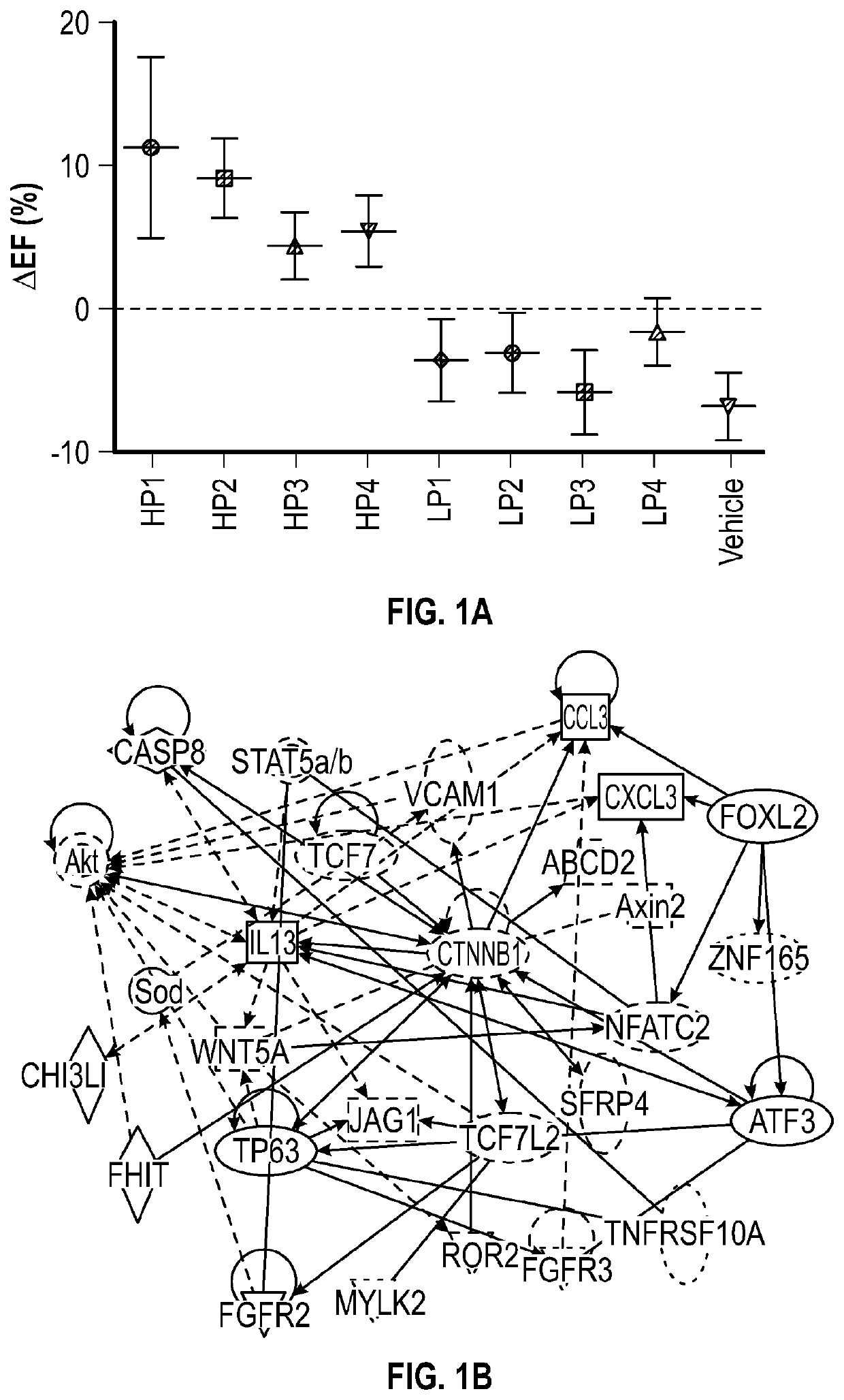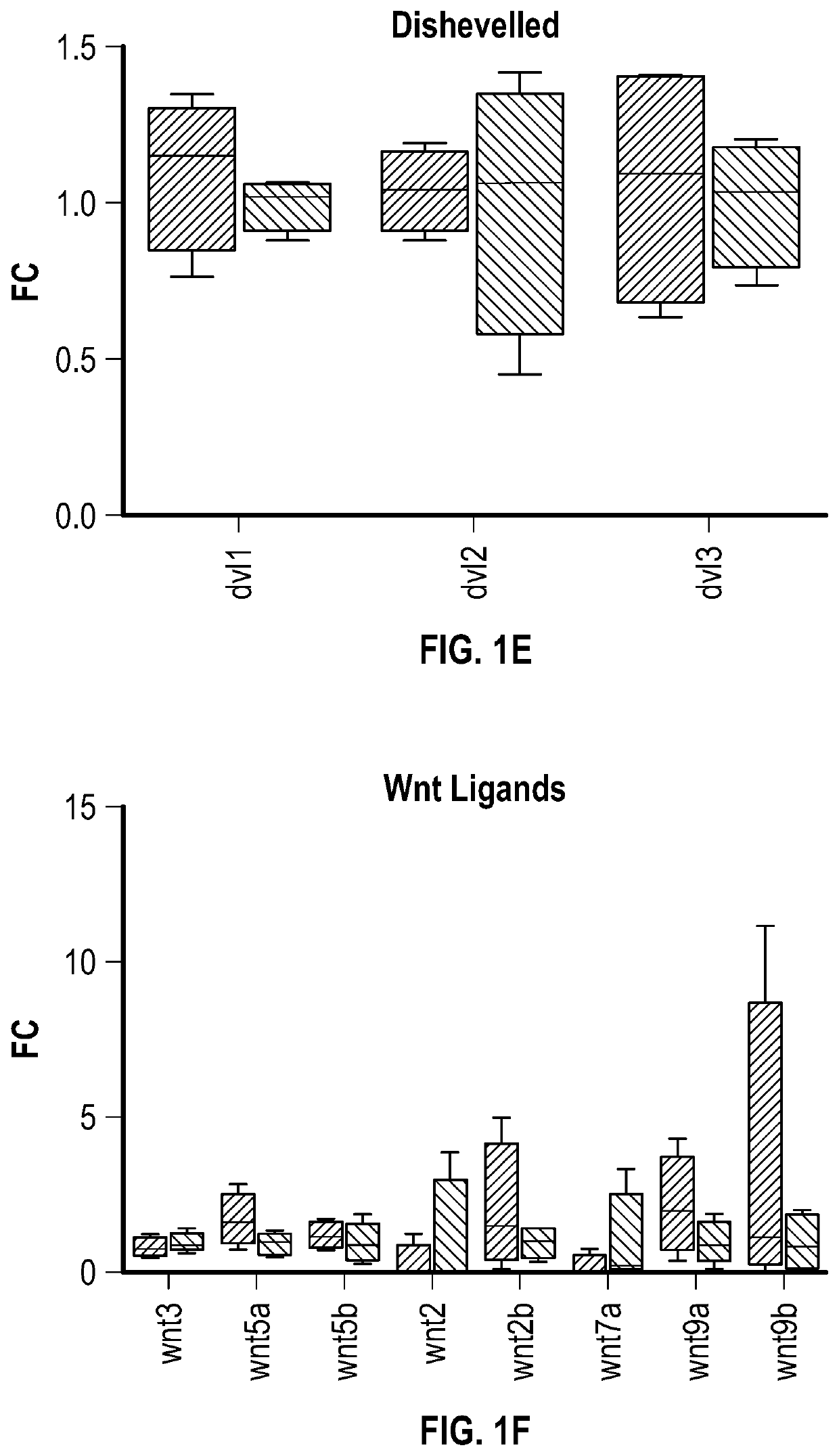Therapeutically active cells and exosomes
a technology of exosomes and active cells, applied in the field of therapeutically active cells and exosomes, can solve the problems of reduced productivity in the workplace, substantial medical costs, and workers compensation costs
- Summary
- Abstract
- Description
- Claims
- Application Information
AI Technical Summary
Benefits of technology
Problems solved by technology
Method used
Image
Examples
example 1
[0149]This non-limiting example describes the implication of Wnt / β-catenin signaling in CDC therapeutic potency.
[0150]Variable therapeutic efficacy is evident among various human CDC lines subjected to in vivo testing post-MI. FIG. 1A shows the changes in global heart function, quantified echocardiographically as ejection fraction (EF), from mice injected with each of four high-potency (HP) human CDC lines, four low-potency (LP) lines (selected for sequencing), or vehicle only (saline). Transcriptomic comparison of HP and LP CDCs revealed differentially-expressed Wnt signaling mediators, with activation of β-catenin signaling in HP CDCs (FIG. 1B). In contrast, non-canonical Wnt pathway members ror2, nfatc2, axin2, rac2, and apcdd1 were enriched in LP CDCs (FIG. 1C), while little difference was evident in several molecules that are shared by canonical and non-canonical Wnt signaling pathways (Frizzled receptors (FIG. 1D), Dishevelled, (FIG. 1E) and Wnt ligands (FIG. 1F)).
[0151]Based ...
example 2
[0154]This non-limiting example shows that boosting β-catenin enhances therapeutic potency.
[0155]To test whether boosting β-catenin levels would improve therapeutic efficacy in LP CDCs, 6-bromoindirubin-3′-oxime (BIO), a reversible inhibitor of glycogen synthase kinase-3 beta (GSK3β) which is maximally effective in CDCs at 5 μM, was used (FIG. 8B). By releasing GSK3β's suppressive effect, BIO can increase β-catenin levels, which was indeed observed in a LP line exposed to BIO (LP-BIO, FIG. 2C). BIO decreased the expression of CD90, an antigen which correlates inversely with potency, without affecting the positive CDC identity marker CD105 or the negative identity marker DDR2 (FIG. 8C). Tideglusib, an irreversible inhibitor of GSK3β, had directionally similar but longer-lasting effects (FIGS. 8D and 8E). LP-BIO CDCs showed enhanced functional and structural benefits compared to unexposed LP CDCs (LP-Vehicle) (FIGS. 2D-2G). Enhancement of β-catenin did not affect the persistence of tr...
example 3
[0158]This non-limiting example describes inhibition of mest expression and increased LRP5 / 6 receptor surface expression upon activation of Wnt / β-catenin signaling.
[0159]To understand how β-catenin drives potency, the transcriptomes of LP CDCs to those of the same cell batches after exposure to BIO were compared. As stated above, three scenarios associated with low potency were identified: donor-related, in which all lots from a given donor lack potency; lot-dependent, in which some lots are potent and others are not; and immortalized CDCs (imCDCs). Using RNA sequencing, LP cells from each scenario were compared after exposure to BIO versus vehicle alone. Fold changes were then pooled to identify genes up- or down-regulated by BIO (FIG. 3A). In addition to the many promoters of canonical Wnt signaling which were up-regulated, one basal negative regulator of Wnt signaling, mesoderm-specific transcript (mest), was strikingly downregulated (˜30-fold; FIGS. 3B, 3C; FIGS. 9B and 9C). Dif...
PUM
| Property | Measurement | Unit |
|---|---|---|
| diameter | aaaaa | aaaaa |
| diameter | aaaaa | aaaaa |
| diameter | aaaaa | aaaaa |
Abstract
Description
Claims
Application Information
 Login to View More
Login to View More - R&D
- Intellectual Property
- Life Sciences
- Materials
- Tech Scout
- Unparalleled Data Quality
- Higher Quality Content
- 60% Fewer Hallucinations
Browse by: Latest US Patents, China's latest patents, Technical Efficacy Thesaurus, Application Domain, Technology Topic, Popular Technical Reports.
© 2025 PatSnap. All rights reserved.Legal|Privacy policy|Modern Slavery Act Transparency Statement|Sitemap|About US| Contact US: help@patsnap.com



